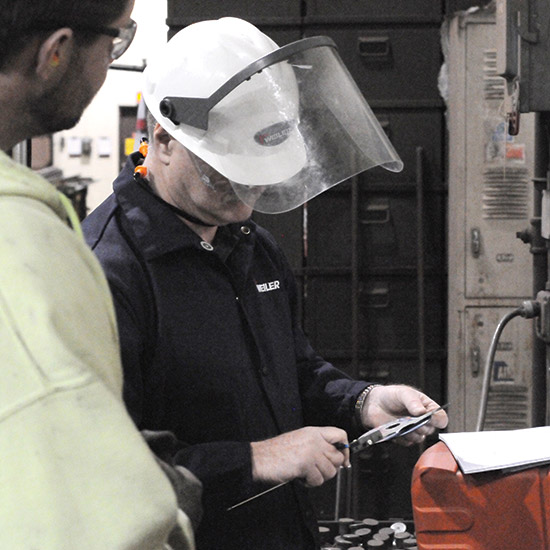Above: By evaluating used abrasives Weiler can help companies answer important questions about product performance and life.
The right surface conditioning products are helping fabricators reduce grinding cycles, save costs and improve results
July 2020 - “One man’s trash is another man’s treasure,” says Ron McCarthy, referring to one of the tools he uses to help manufacturers uncover cost saving options in their grinding operations. An abrasives specialist for Cresco, Pennsylvania-based Weiler Abrasives, McCarthy says he can tell a lot about a company’s processes by looking at the condition of abrasives that operators have thrown away.
“The biggest trend we’ve observed over the last several years is that companies continue to accelerate their efforts to remove costs from production,” says McCarthy. “But that move has also uncovered a second trend, one where performance is being sacrificed for purchase price.”
“Whether we’re talking about sheet metal or airplane parts, the goal is to manufacture products in a safer, faster, more productive manner,” he continues. “But that means being willing to take advantage of improvements. Understanding how to choose and use the right abrasives can reduce grinding cycles, save dollars and guarantee better results.”
Bucket bonanza
The first step is both simple and practical. McCarthy recommends a company begin by asking operators to put used abrasives in buckets instead of throwing them away. “Once I go in and pull the material out of the bucket I can

help the company answer a number of important questions,” he says. “Why were the discs thrown away? Was the edge worn off? Is the disc spitting grain or glazed over? Underlying reasons for wear could be anything from the operator failing to use the disc at the right grinding angles, picking up the wrong abrasive or applying the wrong amount of pressure.”
Weiler Abrasives can also perform a technical evaluation and analysis based on a G-ratio (grinding ratio). G-ratio is defined as the volume of material removed divided by the volume of wheel wear. The tool and workpiece are weighed before and after grinding to determine weight loss.
“The G-ratio tells us how much material can be removed by a disc. This helps the shop understand the life cycle of the abrasive used in that application,” says McCarthy. “We also use an efficiency ratio (metal removal rate or MRR), which takes the same workpiece and the material lost in grinding, referenced by the unit of time (usually in minutes). These measurements reveal cost savings and life cycle data but they also help you decide which abrasive to use.”
In cases where parts are too big to weigh, Weiler Abrasives uses a metal coupon sample for analysis. By weighing the disc and coupon before and after grinding, recording the time and calculating the variables, a company can project product performance and life. These elements can help identify cost savings that can be proven over a 30- to 60-day period.
“Increased product life saves money but it also impacts other things like inventory,” says McCarthy. “If you don’t have to carry five discs, then you save space and reduce your carrying cost. When you consider the overall idea of cost savings, you have to think about secondary costs as well.”
The right questions
“People who perform machining understand that when they buy a drill, they aren’t really buying a drill,” McCarthy continues. “They are buying a hole. The question they have to ask is, ‘How fast will that tool drill holes and how many holes will it drill?’ With fabrication operations, price is often the primary consideration when it comes to purchasing the abrasive. Grain type, life cycle and efficiency aren’t always given the proper gravity.”
Abrasive techniques, grain and cloth, as well as equipment, have improved significantly. “I recently visited a facility that produces T joints, elbows and 90-degree bends for pipe used on pipelines,” says McCarthy. “We conducted a study and found that by changing the grain, the flap width and the count, we achieved a 133 percent increase in the life of the abrasive over the disc they were using. The longer life cycle generated a cost savings of $20,000. If you use a lot of consumables, you could be talking about a substantial cost savings. You can reduce consumable spending even on smaller jobs.”
Understanding a company’s value proposition is important. Can usage be tracked? Is G-ratio or MRR the most important consideration? Sometimes we have to think beyond the product to achieve those results. This is where training comes into play, says McCarthy. The safe use of products is a very effective way to increase performance if a tool is run safely and correctly. In many cases, people are hired and then grinding parts the next day without the benefit of proper training. Weiler Abrasives provides several different types of training, including its SPOT training program. The acronym stands for speed, pressure, orientation and time.
“Safety, efficiency and the ability to maintain cost savings during grinding operations is tied to training,” says McCarthy. “You can’t have one without the other. Safety practices should also extend to the use of personal protective equipment (PPE) and work area cleanliness.”
Weiler Abrasives’ goal is to partner with end users and distributors to help manufacturers overcome cleaning, grinding, cutting, deburring and finishing challenges. “Sometimes the product improvements we make mean that a customer can reduce their usage,” notes McCarthy. “Why would we do that? Because we are about the business of solving problems and creating solutions, not just selling a product.”
Weiler Abrasives
Cresco, Pennyslvania
570/595-7495

